Tony Gobert is so passionate and enthusiastic about Gwinnett Tech’s vegetable garden and the school’s Certificate in Sustainable Urban Agriculture that his face lights up talking about it. On a recent tour I saw a garden FULL of plants. It is urban, intensive agriculture at its best. This garden has a lot to teach community and school gardeners. Tony was happy to tell me all about it.
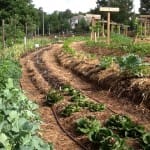 Located along Sugarloaf Parkway in Gwinnett County, Georgia, the garden is laid out to work with nature. The plant rows are laid out to follow the contour of the land. Before the vegetable garden, the land had a history of large runoff problems after rain storms. Tony and his team turned this negative into a positive by controlling the flow of the water so that it provided irrigation to the vegetable plants. “Work with what you have,” Tony says.
Located along Sugarloaf Parkway in Gwinnett County, Georgia, the garden is laid out to work with nature. The plant rows are laid out to follow the contour of the land. Before the vegetable garden, the land had a history of large runoff problems after rain storms. Tony and his team turned this negative into a positive by controlling the flow of the water so that it provided irrigation to the vegetable plants. “Work with what you have,” Tony says.
Being part of an educational garden, there are experiments everywhere. Which creates a better plant in the long run, potatoes started in the greenhouse or potatoes started by slips in the ground? What is the
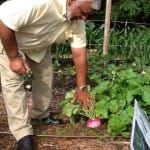
best way to use worm castings? The students can answer these questions because they have tested their hypotheses by planting and growing – not just reading a textbook. The students are also trying their hands at growing fruit trees in different ways and growing different types of alliums. There are even banana plants. Why not?
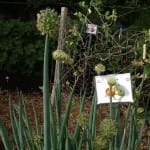
This is a food production garden. The produce goes to Gwinnett Tech’s popular culinary program. The agriculture students learn about what it takes to supply a client as well as other lessons in ag economics. They are taught seed saving techniques and also how to make money during the slower season of the garden.
In many areas there are multi-crop plantings. For example, a Winesap apple tree is grown using a unique tree trellis. Underneath are blackberry bushes. During the cool-season months when there are no leaves on the tree, onions are planted just outside the blackberry bushes.
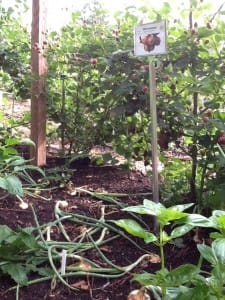
This is true intensive gardening which can translate well in a community garden setting. Peanuts are planted between rows of corn. The peanut plants help fix nitrogen for the nitrogen-loving corn. Blueberry bushes are planted in the middle of the strawberry patch. Their roots use different soil zones. Also, crop rotation and successive planting are thoughtfully carried out.
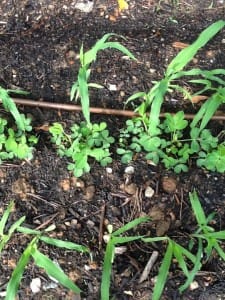
Tim Daly, a Gwinnett County Extension Agent, is a fan of the garden. Tim was curious about a squash variety that was advertised to grow very large squash plants. “Daly’s squash” is part of the garden this year. Tony is feeling hopeful they will get a prize winning squash from that plot!
This garden is just getting started. The initial planting was done in April 2014. A pollinator plant strip was added in November 2014. There are plans for 30 raised beds. The program that supports this garden is also just getting started. The certificate program in Sustainable Urban Agriculture was started in 2013. Students are required to take classes in food production, soils, and pest management. Three other courses are required to finish the six course program. Tony is a teacher at heart and he is excited to hear what his first graduates of the program are doing now as well as the plans his current students have. This is a fantastic addition to the urban gardening movement in Georgia!
I hope you can incorporate some of Tony’s intensive multi-planting systems in your own community or school garden plot.
Happy Gardening!
- ParSLAY the Day! - June 12, 2024
- 6th Annual Great Southeast Pollinator Census - May 28, 2024
- Are you ready for Pepper Palooza? - July 5, 2023
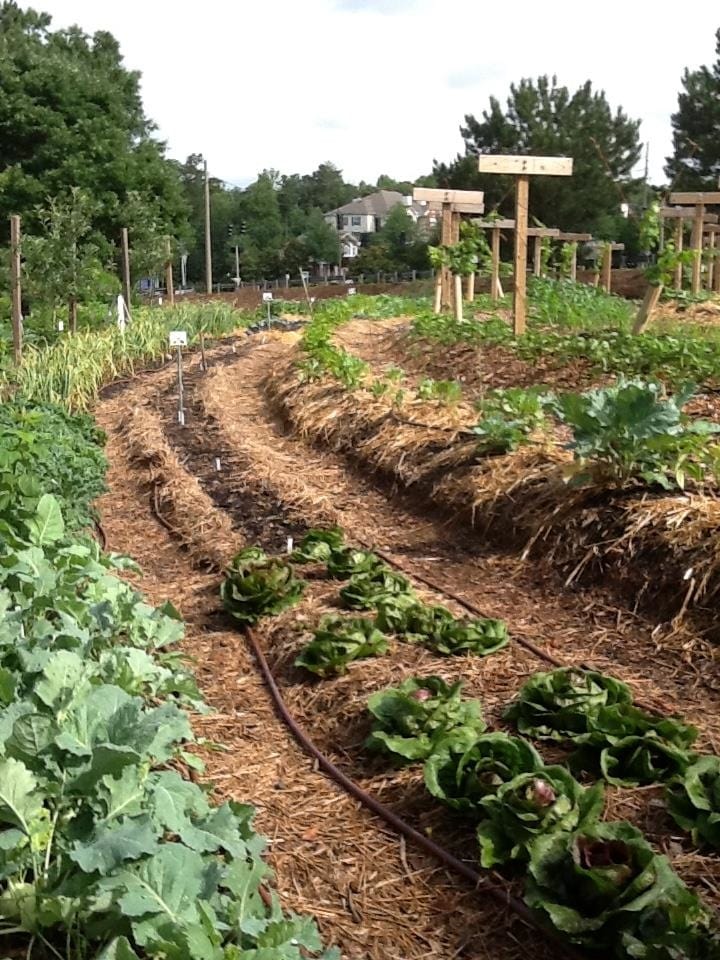
I went for a look around this morning, and it is very interesting. It’s easy to see from Sugarloaf Parkway. Watch out for all the trenches where they’re laying irrigation lines! I look forward to watching this garden develop over time, especially the espalier fruit trees and muscadines. I have many questions about their pest management.